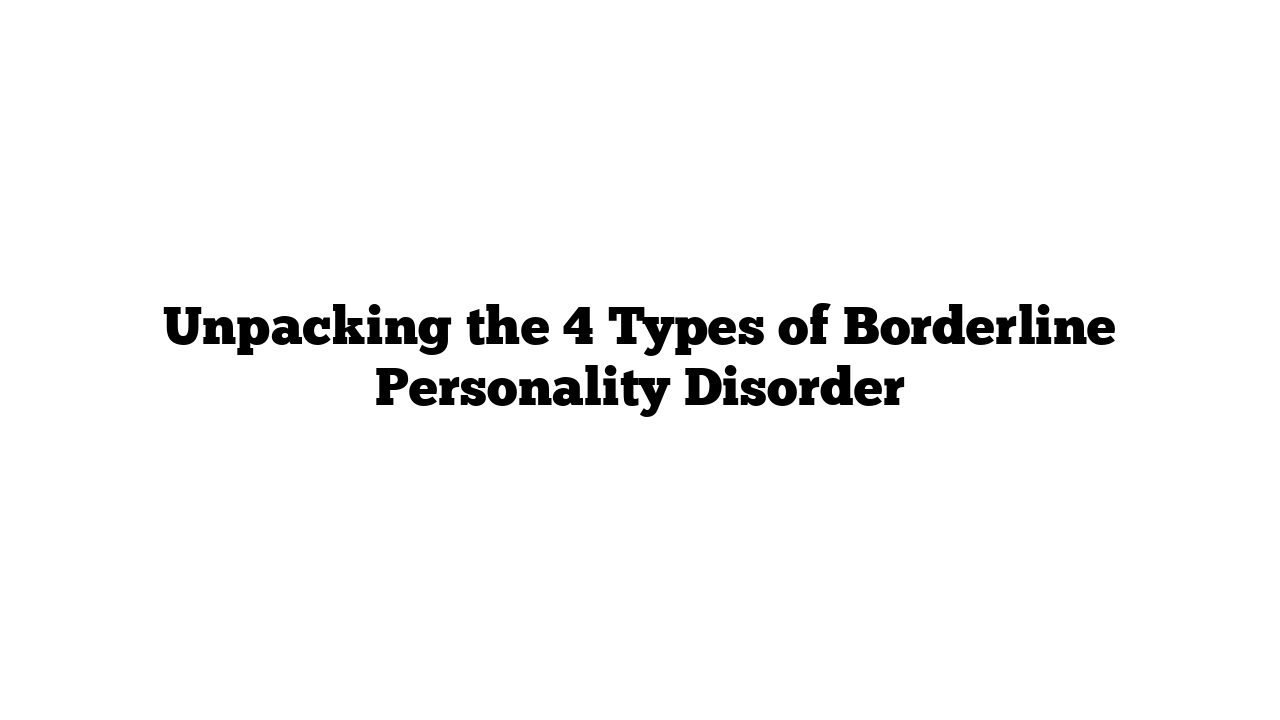Borderline Personality Disorder (BPD) is a complex and multifaceted condition, often misunderstood due to its varying presentations. To provide clarity, American psychologist Theodore Millon proposed four distinct subtypes of BPD: the Discouraged (Quiet) Type, the Petulant Type, the Impulsive Type, and the Self-Destructive Type. Recognizing these subtypes can significantly enhance treatment approaches and promote self-understanding for those affected.
Below, we’ll explore each subtype in depth, examine how they manifest, and outline strategies for managing and coping with their challenges.
The 4 Subtypes of Borderline Personality Disorder
1. Discouraged or Quiet Borderline Personality Disorder
This subtype is characterized by a quiet struggle. Individuals tend to be outwardly reserved but wrestle with intense internal emotions like anger and sadness.
- Key Traits:
- Clingy and dependent on others.
- Often follows the crowd to avoid conflict.
- Suppresses anger but can have explosive outbursts if overwhelmed.
- Struggles with self-harm tendencies, such as cutting or burning.
- Experiences suicidal thoughts and, tragically, sometimes acts on them.
Coping Tips:
- Practice assertiveness: Learn to express needs calmly and clearly.
- Use the “STOP-Think-Act” method to slow down impulsive responses.
- Build emotional resilience through mindfulness and therapy.
2. Petulant Borderline Personality Disorder
Petulant BPD is marked by unpredictable moods and behavior, often swinging between feelings of worthlessness and explosive anger.
- Key Traits:
- Irritable, stubborn, and impatient.
- Complains frequently and resents perceived slights.
- Feels torn between wanting connection and fearing rejection.
- Struggles with expressing emotions constructively.
Coping Tips:
- Express emotions appropriately: Avoid bottling up anger or frustration.
- Practice journaling to identify triggers and improve emotional awareness.
- Develop trust in healthy relationships through open communication.
3. Impulsive Borderline Personality Disorder
This subtype involves high energy and thrill-seeking behaviors, which can mask deeper emotional struggles.
- Key Traits:
- Flirtatious, captivating, and attention-seeking.
- Engages in risky behaviors like substance abuse or reckless driving.
- Struggles with boredom and constantly seeks excitement.
- Can be misdiagnosed as having Histrionic Personality Disorder due to their attention-seeking tendencies.
Coping Tips:
- Pause before acting: Use mindfulness to evaluate potential consequences.
- Channel energy into productive outlets, such as creative hobbies or sports.
- Set clear goals to minimize impulsive decision-making.
4. Self-Destructive Borderline Personality Disorder
The most overtly self-harming subtype, these individuals harbor significant self-hatred and often engage in dangerous behaviors.
- Key Traits:
- Impulsive and indecisive.
- Experiences intense loneliness and frustration.
- Frequently engages in self-mutilation, such as cutting or burning.
- Participates in risky behaviors like substance abuse or reckless driving, endangering themselves and others.
Coping Tips:
- Build a strong social support network of trusted friends, family, or therapists.
- Work on self-compassion and recognizing intrinsic worth.
- Seek structured therapy programs like Dialectical Behavior Therapy (DBT).
Understanding Overlap Among Subtypes
While Millon’s four subtypes provide valuable insights, it’s essential to recognize that many individuals with BPD display traits from multiple subtypes. For instance, someone may exhibit both impulsive behaviors and quiet emotional struggles, depending on the situation or their relationships.
Instead of focusing on rigid labels, individuals should identify their most dominant subtype and work on addressing the specific challenges it presents.
Treatment Approaches and Coping Strategies
Managing BPD requires a holistic and personalized approach. By tailoring techniques to an individual’s subtype, therapy can become more effective.
Discouraged/Quiet Type
- Focus on assertiveness: Communicate needs calmly and directly.
- Use restraint to manage impulsive emotional reactions.
Petulant Type
- Practice expressing emotions constructively instead of suppressing them.
- Work on accepting help from others without fear of rejection.
Impulsive Type
- Develop self-awareness to identify and prevent risky behaviors.
- Slow down decision-making processes using grounding techniques.
Self-Destructive Type
- Build a support system with multiple trusted individuals.
- Focus on harm-reduction strategies to manage self-destructive tendencies.
Why Social Support Matters
For individuals with BPD, isolation can exacerbate symptoms. A circle of support—comprising friends, family, and professionals—can provide emotional stability and guidance.
- Avoid relying solely on one person, as this can strain the relationship.
- Engage with multiple sources of support, such as therapy groups, trusted peers, and online communities.
Final Thoughts
Understanding the subtypes of Borderline Personality Disorder is a step toward empowerment and healing. By identifying which traits resonate most, individuals can focus on managing those challenges and developing healthier coping mechanisms.
For more trusted insights, visit medicaltimes.io. Also, consult reliable resources to deepen your understanding and find the right support for you.
Reference Website:
Top 10 FAQs About Borderline Personality Disorder (BPD)
- What is Borderline Personality Disorder?
BPD is a mental health condition marked by unstable moods, behaviors, and relationships. - Can BPD be cured?
While there is no “cure,” effective treatments like therapy can manage symptoms. - What are the main symptoms of BPD?
Symptoms include mood swings, fear of abandonment, impulsivity, and unstable relationships. - Are the subtypes of BPD officially recognized?
The subtypes are not part of the DSM-5 but are used as helpful frameworks for understanding BPD. - Can people with BPD live normal lives?
Yes, with proper treatment and support, many individuals lead fulfilling lives. - What is Dialectical Behavior Therapy (DBT)?
DBT is a specialized therapy for BPD, focusing on emotional regulation and interpersonal skills. - How common is BPD in the USA?
Approximately 1.6% of adults in the U.S. are diagnosed with BPD, though the actual number may be higher. - What causes BPD?
Factors include genetics, childhood trauma, and brain structure differences. - Can BPD affect relationships?
Yes, BPD can strain relationships due to emotional instability, but therapy can help improve dynamics. - What is the best way to support someone with BPD?
Be patient, encourage therapy, and educate yourself about the condition to offer informed support.
